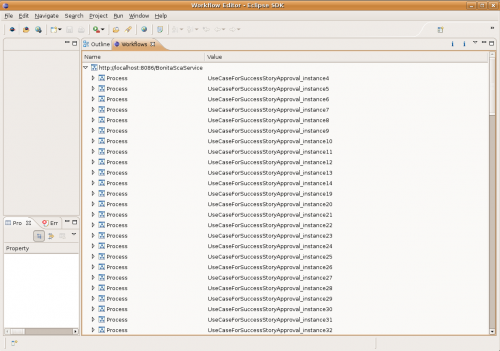Notice: This Wiki is now read only and edits are no longer possible. Please see: https://gitlab.eclipse.org/eclipsefdn/helpdesk/-/wikis/Wiki-shutdown-plan for the plan.
JWT Monitoring
Contents
Introduction
We want to give to JWT the ability to monitor workflow engines (ie AgilPro, Bonita...) at thein runtime; to give the user the ability to check the state of a workflow from Eclipse.
Ideas
- We think that "monitoring a workflow" is a synonymous for "getting full workflow state"
- To define a workflow state, we need a generic API to define a workflow. This API must fit with most of workflow engines. This introspection and query API can be usefully complemented by a consistent workflow management API.
- The monitoring tool must be able to support several workflow engines, and several ways to access them (WebService, RMI, ...)
Workflow State Model
- Workflow Engine
- Process(*)
- name(1) String
- Project(1)
- name(1) String
- version(0..1) String
- properties(*)
- name(1) String
- value(1) String
- Activity(1)
- name(1) String
- state(1) String
- properties(*)
- name(1) String
- value(1) String
- Process(*)
- Query facilities ADDED 201009
- Processes
- start int
- end int
- sizeint
- ProcessQuery
- returnProperties boolean
- start int
- end int
- filterProcesses(*) Process
- Processes
Concretely
- As this work has been done in the context of SCorWare SCA project, first implementation is done with the aim of monitoring a Workflow Engine (Bonita) through WebServices. SCorWare uses CXF webservice engine, with Aegis databinding. That is the only technologies that are currently supported.
- However, we made some efforts to make the architecture extensible enough to handle other bindings; so that it might be easy to add a support for RMI, or an Eclipse internal Workflow Engine (eg MWE) or anything else. This is made by using extension points.
How do I monitor another workflow engine over another binding with this plugin?
- Implement an interface (WorkflowService) with your favorite workflow engine. (We use the "Adapter" design-pattern)
- Make this service accessible to the user who wants to monitor it in Eclipse (you can use webservices, rmi, or anything you are able to write a client programmaticaly)
- Implement an extension plug-in which defines the way to access the service (so called a service provider) from inside Eclipse.
Screenshot
These are a screenshot of what we currently have. Obviously, it can be improved...
Implementation
General Schema
Comments
- The UI is implemented as an Eclipse View
- The view uses the interface WorkflowService, and creates the tree wih the beans that WorkflowService methods provide. Those beans are then embedded in a composite pattern, to fit with TreeViewer requirements.
- The interface WorkflowService is an adapter. Each workflow engine that is to be supported in JWT must implement this interface according to its own specifications.
- When accessing a Workflow Service, the plug-in calls a method from a plug-in linked to the base plug-in through extension point. This extension provides an implementation for the interface WorkflowServiceProvider, and more specifically for its "processServiceAdd" method.
- This way, we can consider that we have one plug-in per binding. (That's why SCA could be useful => One plug-in for several bindings)
Code
WorkflowService API combines both workflow Query and Management APIs :
package org.eclipse.jwt.runtime.workflow; import org.eclipse.jwt.runtime.workflow.bean.Activity; import org.eclipse.jwt.runtime.workflow.bean.Process; import org.eclipse.jwt.runtime.workflow.bean.Processes; import org.eclipse.jwt.runtime.workflow.bean.Project; import org.eclipse.jwt.runtime.workflow.bean.Projects; /** * @author gdecarnin * * NB. These methods do not "officially" throw BonitaServerException because * it will rather result in an UndeclaredThrowableException in a ws client. */ public interface WorkflowService { public Projects listProjects(boolean returnProperties, boolean startableOnly, String login); public Project getProjectProperties(Project project, String login); public Process instanciateProject(Process process, String login); public Processes listUserActivities(boolean returnProperties, boolean returnTerminated, String login); public Process startActivity(Process process, String login); public Activity getActivityProperties(Process process, String login); public Activity setActivityProperties(Process process, String login); public Process terminateActivity(Process process, String login); /** * Allows pagination and server-side filtering. ADDED 201009 * @param processQuery * @param login * @return */ public Processes listUserActivities(ProcessQuery processQuery, String login); }
With SCA
- SCA is aimed to make binding between several components (eg a Workflow Engine that promotes a service to monitor it, and a client to this service that monitor it in another application...) become more abstract. When possible, we could use SCA to manage theses bindings in JWT.
- We could provide a composite generator binary (for SCA) in the base plugin. This is possible by adding a binary without problem of license (see java2wsdl binary in STP), so that it could be part of an official release.






